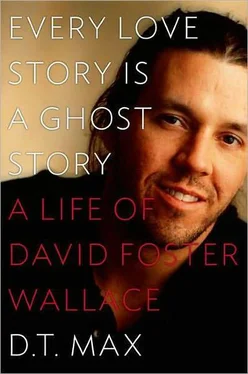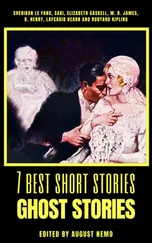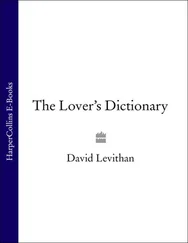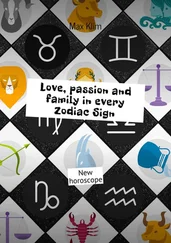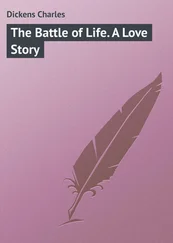Howard was satisfied; he had tried. He was still in awe of the book he held in his hands and felt, with or without a conventional ending, it was, as he remembered, full of “the sheer joy of a talent realizing itself.” He wrote to Nadell, even before he had finished editing Wallace’s book, “It is a great joy to be in at the start of his brilliant career.” 18The title of the book was open to discussion. It had begun, at Amherst, as The Great Ohio Desert, a reference to a fictive human-engineered pile of sand near Cleveland with its suggestive acronym that figures in the story; to Three Deserts (“Rick, Lenore, and the G.O.D.,” Wallace noted to Howard); to The Broom of the System, the name it was submitted to Howard under. Amy Wallace now suggested Family Theater, a reference to the therapy that the Wallaces had undergone as a group in summer 1982, but in the end Broom won out.
Wallace’s life began to go on two tracks. His book was soon to be the first original novel in a fiction line from an important New York publishing house, but he was still a first-year MFA student, facing a faculty less than enchanted by his success. Personal dislike, professional jealousy, and opposition to postmodernism made anything good that happened to Wallace dubious in the eyes of his teachers — at least that was how he read the situation.
Wallace had grown close to a fellow student named JT. “Jate”—no one knew what the initials stood for — was a former marine, who wore a hat and leather bomber jacket in the heat of Tucson. He called his apartment on 9th Street “the lair.” It featured a Soloflex machine in the living room and a stack of Diet Coke cases reaching almost to the ceiling in the kitchen. For Wallace 9th Street became a replacement for the lost “womb” at Amherst. He would go there to relax, hide out from Gale Walden, get high, discuss their fiction, and engage in what he called in a story he wrote of the time “macrocosmic speculations.” JT was the sort of friend Wallace was increasingly drawn to, the sort to whom he could be at once a pal and still somewhat mysterious to. They had a routine together. “How’d you get to be so smart?” JT would ask. “’Cause I did the reading,” Wallace would respond. They called first novels “big shits” because everything you knew got poured out into them. Together with an undergraduate friend they put out a parody issue of the writing program newsletter, a publication of the “University of Aridzona Piety Center”:
How many Jonathan Penners does it take to screw in a lightbulb?
One. Having more than one Jonathan Penner violates basic point-of-view considerations.
How Many Robert Boswells does it take to screw in a lightbulb?
Two: One to screw in the bulb, and one to accept the award.
JT created a joke for Wallace, but the latter cut the entry when he sat at the printing shop alone with the manuscript. The parody offended many of its targets, not entirely a surprise to Wallace, who as they finished up the issue began to downplay his involvement.
JT helped Wallace in crucial ways. Wallace was a child of academia with little knowledge of the larger world. That world frightened him easily and often overwhelmed him, but he saw that without broader experience he was going to have a hard time growing as a writer. Fantasizing about his future biography, Wallace joked with JT one day, “‘Dave sat in the smoking lounge of the library, pensively taking a drag from a cigarette and trying to think of the next line.’” He added, “Who wants to read that ?” JT’s stories held a partial solution. He told him he had been in a severe accident involving an International Harvester truck in the 1970s that had left him in a coma; Wallace put the accident in a story. Another day, early in the semester, as JT remembers, Wallace put on a recording by Keith Jarrett. While they listened to the improvisation, JT told Wallace, who was high, a story about a road trip he took to see the Grateful Dead with his brother, a bouncer nicknamed Big. Just before, Wallace had been flipping through a collection of records put out by Placebo Records, a punk rock label. Many of the Placebo musicians and their associates were friends of JT, and two of their names came up in the road trip story too: Big and Mr. Wonderful. Wallace ran off to his bungalow and a few days later came back with a story narrated by a rampaging young Republican named Sick Puppy who delights in burning women while they fellate him. 19The story starts:
Gimlet dreamed that if she did not see a concert last night she would become a type of liquid, therefore my friends Mr. Wonderful, Big, Gimlet and I went to see Keith Jarrett play a piano concert at the Irvine Concert Hall in Irvine last night.
The story, “Girl with Curious Hair,” was in the same key as Less Than Zero . Wallace felt that employing bored, vapid characters to capture boredom was poor writing, but as a natural mimic he admired the strong voice Ellis had found; he saw its potential. So he pushed the voice past where Ellis had taken it, moving it from the stylish into the gothic or repulsive. 20When Costello came to visit, Wallace recited the opening of A Clockwork Orange , and Costello realized that the Anthony Burgess novel had also been a model for the story his friend had just written. Wallace told his friend that Burgess’s novel showed how to use hyperbolic language to convey deadened emotional states. (The debt to Bret Easton Ellis was one Wallace would never acknowledge. When Howard asked after reading the story whether Wallace had read Less Than Zero, Wallace told him no.)
When Wallace was not with JT, he was with Walden. During the return from Christmas 1985 break, they each had car trouble, so they agreed that it would be romantic to join up and drive in a convoy back to Tucson, Wallace from Urbana, Walden from the South Side of Chicago. The only problem was that Wallace had already agreed to make the trip back to Tucson with his sister, Amy, who was coming to visit him, and his friends Heather from Iowa and Forrest from St. Louis. So when Wallace, Amy, Heather, and Forrest, traveling in two cars, got to Oklahoma, he called Walden, to discover she needed his company while she waited for a mechanic to fix her car. Then he drove off with barely another word, his change of plans pulled off so quickly that his sister’s suitcase was still in his trunk. When he and Gale finally got to Tucson—“two broken cars limping across the desert,” as Walden would remember it in a later poem — they found Amy hurt and bewildered, her feet bleeding from Heather’s borrowed shoes.
On the trip, Wallace listened to the southwestern accents. He had long wanted to write a variation on William Gass’s novel Omensetter’s Luck . The laconic hillbilly voice of the story appealed to him. As a “weird kind of forger,” imitating it would be a fun challenge. “He started to talk out ‘John Billy’ at rest stops,” Walden remembers. “He was trying to get the cadence of the dialogue down.” When he got home, he wrote a draft. “Was me supposed to tell Simple Ranger how Chuck Nunn Junior done wronged the man that wronged him and fleen to parts unguessed,” the eponymous narrator states. There was, as ever, an element of parody in the homage. The goal was to push the original author out of sight. That the story was not easy to read mattered not at all to Wallace; all he cared about was the sentences.
Back at school for the spring 1986 semester, Wallace decided to try to finish his MFA more quickly. From his original boast to Washington that he would stay for “the next three years at least,” he now wanted to try to wrap up his graduate work in two. He may have wanted to be done at the same time as Walden, who was planning to graduate the next June, or to save tuition. He signed up for a workshop with program director Mary Carter, in which he would write extra stories for double credit, as well as a seminar on literary theory and an independent study on the theory and practice of poetry. In the last, when another participant called Derrida a waste of time, Wallace got so mad that everyone thought there would be a fight. He was still convinced that theory was what separated the serious novelist from the others, that without it writers were just entertainers. His interest in theory, like his fondness for stories with strong voices, also had a compensatory element. It served to satisfy energies that would have been frustrated had they gone into aspects of fiction writing he did not naturally excel at, like character development. It was a handy refuge for a writer who was still an odd combination of a mimic and engineer.
Читать дальше
